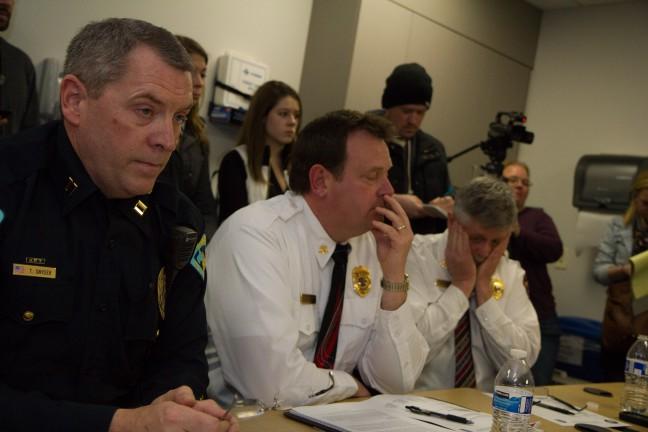The number of law enforcement officers in Wisconsin has reached a record low in 2022, down to fewer than 13,400. The state counted more than 13,500 officers in 2021 and about 14,000 officers 10 years ago. These figures represent the downward trend the state has seen for more than a decade.
At the same time, Wisconsin’s population is increasing. Though 600 fewer officers in a decade or 100 fewer officers in one year may seem insignificant, it constitutes a much larger change when coupled with the 4% population increase in the past 10 years. Regardless of political leanings on the issue of law enforcement, this is a discernible change for Wisconsin communities.
The pandemic is certainly a factor in law enforcement changes over the past few years. For one, unrest has increased the amount of violent crime in Wisconsin, according to the State Department of Justice. Offenses for things like homicide and assault have increased — sometimes dramatically — in recent years.
The war at home: Supporting Ukraine is vital for preserving democracy, global peace
Further, the turbulence of the pandemic highlighted existing inequities, sparking nationwide social protests focused on racial injustice and police brutality. Mass mobilization brought conversations about law enforcement reform to the forefront, impacting the political landscape of the criminal justice system as a whole.
The “defund the police” movement has attracted backlash despite offering legitimate criticisms and reasonable solutions to many issues in law enforcement. Defunding the police is not the same as abolishment but rather delegating funding and responsibility to other government sectors.
Currently, police officers are tasked with non-emergency situations and administrative responsibilities, which takes away time, energy and resources from addressing issues like violent crime. Defunding the police would allow more specialized agencies to alleviate the workload of police officers with reallocated funding.
More progressive outlooks on law enforcement are emerging, with some arguing that police officers who are trained to handle violent crime should not have contact with communities more generally. This argument becomes especially relevant when coupled with the fact that different demographic groups have different experiences with policing.
For example, Black Americans made up about 26% of all arrests in 2020, despite making up less than 14% of the population. Black people are also about five times more likely than white people to report being unfairly stopped by the police because of their race, according to the Pew Research Center. These disparities emphasize the importance of reconsidering law enforcement’s role in society.
UW must live up to Title VI expectations after receiving $4 million in federal funding
But budgetary and systemic reforms take time, and meanwhile, violent crime is still on the rise. Milwaukee is a particularly notable example. The number of homicides in 2021 was 193, and the city is on track to set a new record in 2022. Overall, crime increased by 26% from 2020 to 2021. The Milwaukee Police Department is also about 3% understaffed, according to the Wisconsin State Journal. Some attribute the consistent increase in violent crime to this shortage.
Though many argue that police funding should be reduced, others insist that budgetary constraints are a major factor contributing to law enforcement shortages and subsequent challenges. Advocates of this belief say that increased budgets could allow forces to increase the recruitment and retention of experienced officers.
While this may be true, budgets, as they are, fail to balance the demand for officers both in the field and in correctional facilities. Marinette County Sheriff Jerry Sauve said to the Wisconsin State Journal that they often have to pull officers from the field to meet staffing requirements in the county jail.
Wisconsin’s mass incarceration issue poses an even larger challenge. The incarceration rate in the state is 663 per 100,000 residents and has increased significantly over the past several decades. This phenomenon results from several factors, including harmful responses to crime like long prison sentences and “tough-on-crime” policies that disproportionately impact marginalized groups.
While under-policing can also leave communities feeling neglected, the state would have to consider how increasing the number of officers in the field might contribute to over-policing, perpetuating the mass incarceration crisis. As long as police officers are in the field, making more arrests than the system can address, staffing jail and prison facilities will continue to be an issue.
Madison has one of the more progressive police forces across the state. In practice, this means they use more integrated approaches to address crime rather than asking officers to respond to all situations.
More must be done for students of color in wake of President Biden’s loan forgiveness plan
One program, called Community Alternative Response Emergency Services (CARES), diverts 911 calls that don’t require a police officer to an EMT and a counselor. The program has seen success so far, as specialized response teams have been better able to address hundreds of emergency calls.
The Milwaukee Police Department is looking to implement a similar program, but they need more funding to make it possible. In the meantime, they will continue to rely on 10 community service officers — civilians who respond to non-emergency calls.
Undoubtedly, certain government sectors that address crime need more funding. But instead of funneling money into police departments alone, budgeting needs to be part of integrated reform efforts to reduce crime. Reallocating responsibilities will not only ease the workload of police officers but divert responsibilities to agencies that are better fit to address certain issues.
The issue of law enforcement reform cannot be resolved with just a handful of policies or budget adjustments. It involves giving police departments the resources they need to address violent crimes while also strengthening and repairing relationships with communities to prevent these crimes from occurring in the first place.
Larger police departments do not necessarily equate to less violence. Funding has to provide broad support that reflects the nuances of crime on a systemic level, allowing many agencies to provide services in supporting communities. Clearly, expecting the police to solve a breadth of social issues is holding us back from fully addressing the crisis of violent crime.
Celia Hiorns ([email protected]) is a sophomore studying journalism and political science.














